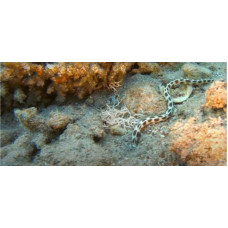Latin name
Ophichtus macrorhynchus
Other names
Snake Eel
Identification
Snake eels of the family Ophichthidae have a long, cylindrical, snake-like body and can move backward extremely efficiently. Their tails are stiff and sharp, not wide and flat like those of moray eels. The snake eel's tail is used like an awl to burrow its tail forward into the sand or silt. The nostrils are located in two short, strong barbs on the top of the nose, which the eel uses to probe crevices and cavities in finding of food. In most snake eels, the dorsal fins extend almost the entire length of the body, starting just behind the head and ending at the tips of the tails. The anal fins are only half as long as the body and also end in front of the tail tips. The pectoral fins are absent or very low.
Distribution
Snake eels are found all over the world in subtropical and tropical seas, with some entering temperate waters.
Habitat
One of the several dozen species in the Atlantic and the Caribbean is the spotted snake eel (Ophichtus ophis), averaging 2 feet in length and occasionally growing to 4 feet. Its yellowish body is covered with large brown spots. The yellow snake eel (O. zophochir) is a similar species that lives in the Pacific.
Size
Only a few of these species reach more than 3 feet in length; most are less than a foot long.
Life history and Behavior
No information
Food and feeding habits
It feeds on fish and crustaceans.It feeds on fish and crustaceans. Finds prey by smell. Active during the day and at night.
Reproduction
No information
| Classification | |
| Phylum | Chordata |
| Class | Actinopterygii |
| Squad | Anguilliformes |
| Family | Ophichthidae |
| Genus | Ophichtus |
| Species | O.macrorhynchus |
| Features | |
| Conservation status | Least Concern |
| Habitat | bottom |
| Life span, years | No information |
| Maximum body weight, kg | No information |
| Maximum length, cm | 140 |
| Sailing speed, m/s | No information |
| Threat to people | Edible |
| Way of eating | predator |



